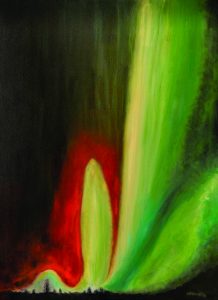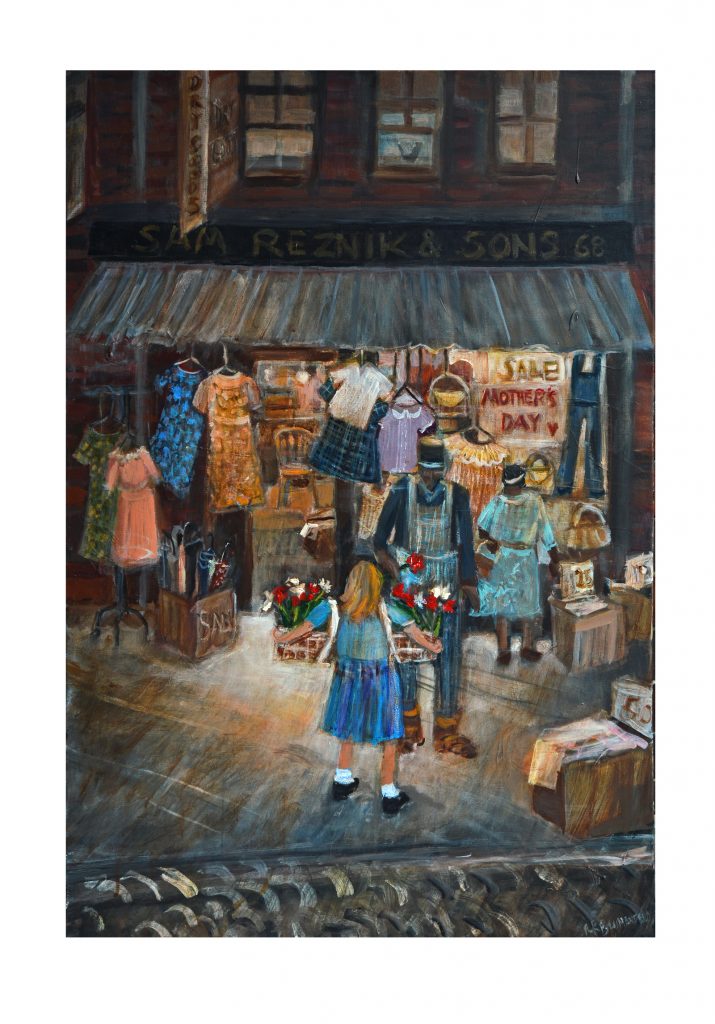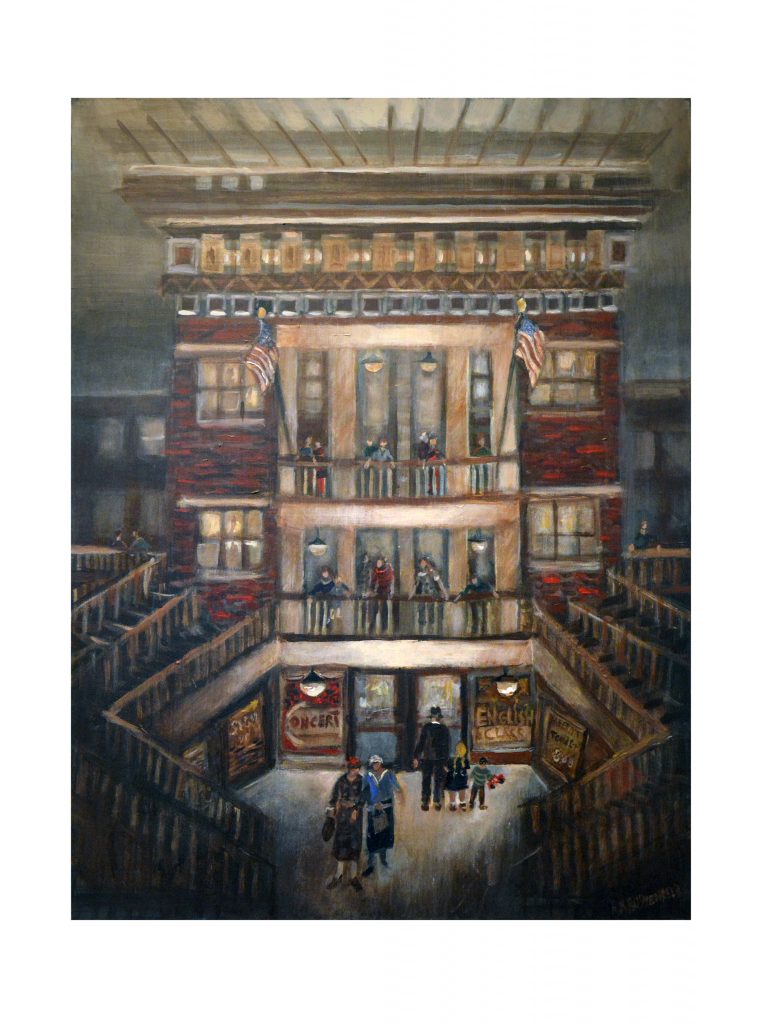- Center for Loving Kindness
- Fitness & Wellness
- JCC Camps
- Sports, Aquatics & Dance
- Early Childhood
- Children, Teens & Family
- Adults
- Jewish Life, Arts, Events, Rentals
- Giving
American Jewish Museum
Thought-provoking exhibits
The American Jewish Museum, housed in the JCC in Squirrel Hill, explores contemporary Jewish art that facilitates dialogue about art, philosophy and culture to promote interfaith and intergenerational explorations.
Judy Robinson and Kara Snyder: The Art of Friendship
Artist Reception
Sunday, September 29 • 3–5 pm
Free and open to all
American Jewish Museum/Ostrow Palm Court
JCC of Greater Pittsburgh • 5738 Forbes Ave • Squirrel Hill
RSVP HERE
“I feel like I have always known Judy Robinson. Our lives were intertwined
even before we met. Both devoted to the arts, we have collaborated on
numerous ideas and projects over the years. The energy of Judy’s presence in
my life is affirming, lively and comforting.” —Kara Snyder“My mother used to say that ‘one heart knows another,’ and that is true. When
I met Kara Snyder, I was drawn to her tender, pure, generous soul. I loved
her instantly, and I loved her work. I felt we had a shared artistic sense. I was
delighted that she agreed and returned the love.” —Judy Robinson
Exhibit continues through December 20, 2024
The Art of Friendship features a collection of 21 paintings by artists Judy
Robinson and Kara Snyder. While each artist’s work is unique and distinct in
style, the exhibition explores ways their paintings harmonize, drawing upon
the synergies between their artistic expressions.
Their enduring friendship and commitment to collaboration and their
exchange of ideas capture the essence of the havruta tradition—a traditional
Jewish method of collaborative learning rooted in the Aramaic word for
“friend.” This tradition emphasizes growth and exploration through the process
of engaging, debating, and wrestling over ideas together, much like Robinson
and Snyder’s creative journey.
Contact 412.697.3231 or mhiller@jccpgh.org for more information.
Recent Exhibit: Violins and Hope - From the Holocaust to Symphony Hall: Daniel Levin
The JCC’s American Jewish Museum presents
Violins and Hope – From the Holocaust to Symphony Hall: Daniel Levin
JCC Squirrel Hill Palm Court · October 15-December 8
Artist Reception and Talk with Book Signing
Music by the Edgewood Symphony Orchestra
Sunday, October 22 • 1-3 pm • JCC Levinson Hall
Free and open to the public • Register HERE
The JCC’s American Jewish Museum exhibition, Violins of Hope – From the Holocaust to Symphony Hall, includes 43 photographs by Daniel Levin chronicling the work of Ammon Weinstein, the master violin maker and restorer responsible for the discovery and repair of the violins making up Violins of Hope and for the vision of bringing these instruments’ remarkable stories to the public’s attention. Notably, Levin, who visited Weinstein’s Tel Aviv based workshop to photograph the restorations in progress, is the only photographer to capture his masterful techniques to save them from being erased from history. The extraordinary stories behind the violins are included in audio-form by scanning QR codes that accompany each image.
To learn more visit: violinsofhopepittsburgh.com/events-pittsburgh/
Recent Exhibit
EACH AND EVERY: PHOTOGRAPHY EXHIBIT
Fine, Perlow Weis Gallery JCC of Greater Pittsburgh • 5738 Forbes Avenue
September-December 2019
Each and Every explores the power of six Pittsburgh-based organizations that are each and every day making our corner of the world a better place to live in.
 The essence of the exhibition is exploring the human need of our neighbors and celebrating the work of dedicated residents who are changing our community. The featured organizations, as well as so many others
The essence of the exhibition is exploring the human need of our neighbors and celebrating the work of dedicated residents who are changing our community. The featured organizations, as well as so many others
throughout the region, are doing the hard work that exemplifies transforming the concept of neighbor from a geographic term to a moral
concept.

The exhibition includes an impressive selection of 30 photographs by distinguished photographers who each spent an entire day
with 412 Food Rescue, BikePGH, Kelly Strayhorn Theater, Fund My Future, Pittsburgh Glass Center and Velocity. The photographers in the exhibition include Nancy Andrews, Rebecca Kiger and Annie O’Neill.
Recent Exhibit
The Loving Kindness of Fred Rogers: Photos by Jim Judkis
Artist reception May 15 • 6‐8 pm
May 8-July 30, 2019
A 96-page hard-bound publication with 65 illustrations and numerous contributions will be available for sale at the artist’s reception and on Amazon.
The Loving Kindness of Fred Rogers: Photos by Jim Judkis includes a powerful selection of 60 photos that capture Rogers in tender, candid moments and reveal the Mister Rogers’ Neighborhood show behind the scenes.
Judkis’s photographs, most of which have never been on display, include images that portray the show behind the set, shot in 1985 for Sunday Magazine and Pittsburgh Magazine. These photos, a combination of black and white and color images, reveal the creative and technical processes of how the show was made and highlight the straightforwardness of the show’s set design and production. They show the serious business of putting together a television show, but they likewise reveal the revelry, energy and camaraderie of the cast and crew. Another set of photos, made in 1978 for People Magazine, portrays Rogers interacting warmly—in his element—with a group of young children at Carnegie Mellon University’s daycare program and at The Children’s Institute of Pittsburgh.
An acclaimed photographer, Judkis captures Rogers in an organic, authentic and candid way. Judkis, who established a long-term relationship with Rogers and Fred Rogers Company, also created the images for the First Experiences book series.
The photos in the exhibition illustrate Rogers’s ease and capacity to express genuine care and embrace children for who they are. They show the simple, non-glossy structure of the television program, drawing attention to his preference for unhurried directness, authenticity and home-spun simplicity. Judkis’s photographs are especially poignant because they capture Rogers’s true nature and draw us into his world, reminding us to be kinder to our neighbors and to ourselves.
The Loving Kindness of Fred Rogers: Photos by Jim Judkis is made possible in part by The Benter Foundation and the Tracy and Evan Segal Family Foundation. The American Jewish Museum is supported in part by the Allegheny Regional Asset Board, Anna L. Caplan & Irene V. Caplan Fund of the Jewish Federation of Greater Pittsburgh, Robert C. and Gene B. Dickman Fund, Ira and Nanette Gordon Curator Enrichment Fund, Edward N. and Jane Haskell Endowment Creative Projects Fund, Nancy Bernstein and Robert Schoen Fund, Pennsylvania Partners in the Arts, and individual support.
Recent Exhibit
AMERICAN PATRIOT:
PHOTOGRAPHS BY CHARLEE BRODSKY, POETRY BY JIM DANIELS
October―December, 2018
 American Patriot includes photographs by Brodsky of American flags that she finds in residential neighborhoods throughout southwestern PA, northern WV and eastern Ohio. Daniels’ poems are rousing interpretations of Brodsky’s photos. Through the symbolism of the American flag, their collaboration wrestles with the complexities of life in 21st century America, the meaning of the American flag, and the very nature of patriotism and American values.
American Patriot includes photographs by Brodsky of American flags that she finds in residential neighborhoods throughout southwestern PA, northern WV and eastern Ohio. Daniels’ poems are rousing interpretations of Brodsky’s photos. Through the symbolism of the American flag, their collaboration wrestles with the complexities of life in 21st century America, the meaning of the American flag, and the very nature of patriotism and American values.
Charlee Brodsky is a fine art documentary photographer and a professor of photography at Carnegie Mellon University. Visit charleebrodsky.com and thespotpress.com to learn more.
Jim Daniels’ seventeenth book of poems, The Middle Ages, was recently released by Red Mountain Press. A native of Detroit, Daniels is the Thomas Stockham University Professor of English at Carnegie Mellon University.
Programs in conjunction with American Patriot include:
ROCK STARS: LEONARD BERNSTEIN
This program is presented in collaboration with Bach Choir of Pittsburgh. An artist, activist and humanitarian, Bernstein declared shortly after President Kennedy’s assassination: “This will be our reply to violence: to make music more intensely, more beautifully, more devotedly than ever before.” Honoring Bernstein’s centennial celebration, concert selections will explore his life, Jewish identity and activism. Visit leonardbernstein.com/at100 or bachchoirpittsburgh.org/ for more information and to buy tickets.
- Saturday, November 10, 8 pm
- Sunday, November 11, 4 pm
Katz Performing Arts Center, Robinson Building, 5738 Darlington Road, Squirrel Hill
FILM SERIES
Becoming American: A Documentary Film and Discussion Series on Our Immigration Experience
This six-week program, presented with Duquesne University and Jewish Family & Community Services, features documentary films designed to encourage an informed discussion of immigration issues. The JCC is one of thirty-two sites nationwide to host this program series. Visit becoming-american.org for more information.
Made possible by a major grant from the National Endowment for the Humanities: Exploring the Human Endeavor. “Becoming American” is a project of City Lore in collaboration with the Immigration and Ethnic History Society and the International Coalition of Sites of Conscience.
Free and open to all
Mondays, 6:30 pm
- October 8, 15 and 22: JCC Katz Performing Arts Center, Robinson Building, 5738 Darlington Road, Squirrel Hill
- October 29, November 5 and 12: Duquesne University College Hall
Recent Exhibit
Paintings of the Cosmos by Jerry Segal
I Am But Dust and Ashes,
For My Sake the World Was Created
May 14–July 29, 2018
Artist Reception • Wednesday, May 30 • 6-8 PM • Free and open to all
In awe of the vastness of the universe, Jerry Segal paints compositions of spiraling, billowing gaseous star formations known as nebula. His compositions are derived from NASA’s Hubble Space Telescope and evoke prismatic landscapes, trippy other-worlds or wildly chromatic abstract compositions.
 Introduced by NASA in April 1990, the Hubble Space Telescope is a scientific instrument that documents critical data enabling astronomers to measure the age of the universe, identify quasars, discover gamma-ray bursts, locate dark matter and see galaxies in different stages of formation.
Introduced by NASA in April 1990, the Hubble Space Telescope is a scientific instrument that documents critical data enabling astronomers to measure the age of the universe, identify quasars, discover gamma-ray bursts, locate dark matter and see galaxies in different stages of formation.
While the interstellar cosmos that Segal depicts represent a part of this universe that is real, it is wholly out of reach to the naked eye and will only ever be visually accessible to us through Hubble’s photographs. Powerfully, the instrument records star formations that are billions of light years away and therefore no longer even exist.
The unfathomable unknowability of the universe that intrigues Segal has likewise puzzled philosophers, scientists, artists and laymen for as long as humans have existed. Astronomers studying Hubble photos recently confirmed that there are
more than 200 galaxies and that some are as old as 13.2 billion years. Twenty-first century technology might provide us with valuable information merely hinted at centuries ago, yet Hubble’s images create more questions than provide answers.
For Segal, an essential question considers our human role in the scheme of the universe. While he aims for viewers to lose themselves in his compositions of hazy cosmic vapors, he also hopes to spur self-reflection about our human responsibilities to our physical environment and earth’s sustainability. Our planet’s resources are being depleted, and Segal’s images implore us to contemplate how we walk through the Earth and what values we prioritize.
Although the Holocene Epoch is the name of the current period of geologic time, many scientists propose that we call the epoch Anthropocene because human activity is modifying the planet on a geologic scale through radioactivity, deforestation, oil drilling, agriculture, fossil fuel consumption and the movement of people. From a
geologic perspective this means our behaviors and patterns over the past 50 years have accelerated change to the Earth’s systems that will mark the geologic record for millennia.
It is difficult to square the knowledge of our swift and substantial impact on the physical planet with Stephen Hawking’s assertion that the human species is mere chemical matter and is utterly insignificant. Segal wonders how, then, do we operate in this dual paradigm where humans are simultaneously inessential but also influential, and how do we grasp our moral obligations to each other and to the physical world that we inhabit for such an inconsequential period of time yet have such a great impact on?
Lending some clarity, a 17th century Jewish teaching with inherent tension states, “I am but dust and ashes, for my sake the world was created.” An expression of humility that acknowledges our impermanence, the first part expresses the idea, akin to Hawking’s, that humans are formed from dust of the earth and return as dust to the earth when our lives end. The second phrase affirms our individual uniqueness and validates that each of us holds meaning and greatness in the world.
Ensuring that we’re always reminded that the contradictory phrases reflect human conditions that actually work in concert, the teaching instructs us to write each phrase on separate pieces of paper and to keep them into our pockets. When we’re experiencing despair or over-confidence, we’re to pull out from our pocket the expression that will help ground us and keep our attitude in check. In brass-tacks terms, the expression confirms that our time is limited. We can walk through life with arrogance and do much to wreak destruction or with awareness that we shoulder great responsibility.
Certainly, as humans we do both. The imperative, which Segal’s inquiries conjure, is that we recognize the interconnections of our actions and that we take personal responsibility to cultivate solutions around protecting the resources that make up the foundation of our ability to thrive.
—Melissa Hiller, American Jewish Museum Director
Recent Exhibit
CHUTZ-POW! VOLUME THREE, YOUNG SURVIVORS
Through April 20, 2018
CHUTZ-POW! Superheroes of the Holocaust is a comic book series created by the Holocaust Center of Pittsburgh that honors Holocaust survivors, resistance fighters and liberators by placing stories of sacrifice, courage, and resilience at the forefront of Holocaust awareness. The exhibition, co-presented by the American Jewish Museumand the Holocaust Center, includes the 36 original storyboard illustrations used to make the recently published CHUTZ-POW! Volume Three, Young Survivors.
The focus in Volume Three turns to the ordeals of young survivors, where viewers discover the wide-ranging experiences that youth endured during the Holocaust. Despite their travails—as hidden children, visible-hidden children, ghetto and camp survivors, and refugees—these vulnerable victims emerged from incredible hardships
to represent a strength of spirit that refused to be oppressed.
These are the childhood experiences of Walter Boninger, Inge (Berg) Katzenstein, Solange Lebovitz, Judah Samat, Irene Skolnick and Sam Weinreb, all of whom settled in the Pittsburgh area. Notably, their stories were chronicled by some of Pittsburgh’s most acclaimed comics writers
and illustrators, including Xeric Award winner Wayne Wise, writer/artist M.L.Walker, Lambda Literary Award winner Mark Zingarelli, writer Yona Harvey, writer Deesha Philyaw, Xeric Award winner Rachel Masilamani, Reuben Award winner Vince Dorse, and veteran comics artists Howard Bender and Loran Skinkis.
While the narratives and images are exceptional, what makes CHUTZ-POW stand out is the time that the writers spent with survivors to learn their stories and to get to know them to make sure their experiences are
interpreted with honesty, integrity and understanding.
Join us on Sunday, February 11 • 3 PM – Holocaust Center of Pittsburgh
826 Hazelwood Avenue, Pittsburgh, PA 15217
Newly published CHUTZ-POW! Volume Three: The Young Survivors comic book will be unveiled, and several of the survivors whose stories are featured will be in attendance.
CHUTZ-POW! Behind the Scenes Artwork from Volumes One and Two will be on display at the Holocaust Center.
Holocaust Center Hours
Monday, Wednesday, Friday: 10 AM–2 PM
412-421-1500 or info@hcpgh.org HCOFPGH.org
Recent Exhibit
- PRYSE – showcase at Sampsonia Way
Out of Many: Stories of Migration
Through December 30, 2017
Reception: Thursday, November 2, 6-8 pm
Out of Many: Stories of Migration, is comprised of photographs that document the experiences of multiple generations of immigrants and their descendants in Pittsburgh. The photographs accentuate the key role that immigration has played in this corner of the world, including shaping our neighborhoods, the formation of our identity, in sustaining our economy, and in the enrichment of our cultural diversity. Comprised entirely of new work by Brian Cohen, Scott Goldsmith, Nate Guidry, Lynn Johnson, and Annie O’Neill, Out of Many considers Pittsburgh’s stories as a lens through which to consider the broader American immigrant experience.
Out Of Many: Stories of Migration is a Documentary Works project organized by Brian Cohen and Laura Domencic and produced by a collaboration of professional photographers based in Pittsburgh.
Community partners include City of Asylum, Jewish Family and Children’s Services, Repair the World, Union Project and the Westmoreland Museum of Art.
Phat Man Dee & Liz Berlin: Shine the Light with Social Justice Disco
Don’t miss the only opportunity to see the first live performance of Shine the Light with Social Justice Disco with Liz Berlin of Rusted Root and jazz singer Phat Man Dee, co-presented by the JCC’s American Jewish Museum and the Center for Loving Kindness and Civic Engagement:
JCC of Greater Pittsburgh • Katz Theater
5738 Darlington Avenue
Thursday, December 14, 7:00 pm •
$10-$25 Private meet and greet with the artists: 6:30pm Ages 13+ • Cash bar
TICKETS: bit.ly/socialjusticedisco
Recent Exhibit
Rochelle Blumenfeld: Hill District Paintings
- Mother’s Day
- No Sale
- Irene Kaufmann Settlement
For more on the exhibit, continue reading about Rochelle Blumenfeld
Recent Exhibit
Recent Exhibit
American Jewish Museum Partners
Please visit the web sites of the organizations that generously support the American Jewish Museum and its exhibitions.
Light Your Spark is supported by
The Hyman Family Foundation.
Major funding for the American Jewish Museum provided by the Allegheny Regional Asset Board, the Anna L. Caplan & Irene V. Caplan Fund of the Jewish Federation of Greater Pittsburgh, the Robert C. and Gene B. Dickman Fund, Ira and Nanette Gordon Curator Enrichment Fund, Edward N. and Jane Haskell Endowment Creative Projects Fund, the Nancy Bernstein and Robert Schoen Fund, the Speyer Family Foundation Endowment Fund, Pennsylvania Partners in the Arts, and individual support.
We maximize accessibility of services for people of all abilities. For more information, contact Cathy Samuels at 412-697-3501.
Contact Us
Melissa Hiller
American Jewish Museum Director
412-697-3231

































